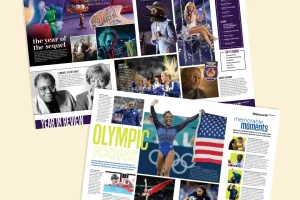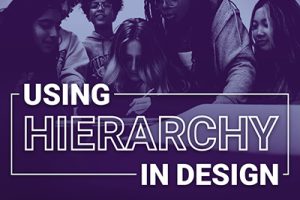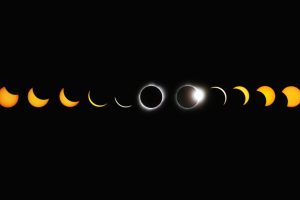Bargains at the Mall
Mall crawling is an inexpensive means to collect ideas for yearbooks
Teens are familiar with their local mall — the location of their favorite stores, favorite eating spots and the best places to hang with their friends.
A mall needs to be an attractive environment that draws customers inside, leads them around and makes them want to linger. It is similar to a yearbook in that it needs to draw readers inside and make them want to stay for a while.
So what better place to get design, copy and font ideas than at your mall? The ideas are a bargain. For the price of time and gasoline to get there (you were going anyway, right?), malls are a great place to walk and search for ideas. Recent expeditions to two malls yielded ideas in several categories. Many of the ideas were very adaptable, while a few were just curious.
The big and little picture
Cindy Wood, adviser at Blue Springs South High School, Blue Springs, Mo., walked into Independence Center, Independence, Mo., with two of her staff members, Amanda Hornick, editor, and Mary Ellen Poff, sports editor. Immediately they noticed how the mall directed your focus.
Poff noted how the floor, the escalators and the lines and texture of the ceiling all pointed shoppers in desired directions.
“The lines draw you to the stores.”
Independence Center has a design theme — stars. Gazing from the center of the mall, they could see stars all around — the wooden beams holding the ceiling lights, the floor tiles, and the umbrellas on the food court. Other objects had points, like a pentagon- shaped newsstand and the tables at the food court. From the floors to the ceilings, mall management tries for a cohesive look, as the photo above shows.
After walking for a while, Amanda summed it up. “Look at all the little things. They remind me of folios. They’re there but you don’t necessarily notice them.”
More about layout
If the mall was like an overall yearbook design, the stores were like the individual stories. Some stores had clean lines with room to walk around the merchandise. Some even used design to draw in a customer.
Naturalizer shoe store had two rows of black hassocks and a long white display shelf situated like arrows pointing the way in. The red carpet with dark gray lines was fun, and the shoes stood out on the white walls and shelving. It was a simple, inviting design with good use of white space and spot color, like a well-designed spread.
Many women’s clothing stores had the same type of clean lines — straight rows and neat displays. Mixed in were the “grunge look” clothing stores. The stores were dark, aisles were barely visible and displays were piled with merchandise. Some shoppers would be turned off, but others would find it inviting and comfortable, like a teenager’s bedroom. The lesson — know your audience.
Use of color
The White Barn Candle Co. had an open storefront so customers could see the products — many colors grouped together against a blazing white background. It was good use of background and color to direct the viewers’ eyes.
Becky Tate, adviser at Shawnee Mission North High School, Overland Park, Kan., visited Mission Center Mall, Mission, Kan., and noticed the same treatment at Bath & Body Works — the white background with the colorful products that pop out at the customer.
“Look how they segment color. This is what you see at places like this. Permanent products have colors that are more lasting. Others are more trendy,” Tate said.
Bath & Body Works and White Barn Candle Co. are owned by Limited Brands, Inc., as are The Limited and Victoria’s Secret. All four of those stores are bright and neat in appearance, and the merchandise is easy to see.
Headlines
Tate really likes Bath & Body Works, and not just for the color. She likes the containers, the text on signs and products, even the textured look of the yoga mats. She picked up the True Blue Spa line, a little group of moisturizing products. Of course, the varying blue shades stood out to Tate, but so did the “fun titles and copy:”
toe the line
(foot scrub)
i’m in the mood for scrub
(sudsing skin scrub)
look ma, new hands
(renewing hand lotion)
footloose and fancy fizz
(foot soak)
lay it on thick
(body cream)
These were only some of the products. In addition to the titles, which would make great headlines, Tate said, the packaging had fun fonts and designs. The copy for the type of products, in parentheses above, were placed in circles, and other circles were on the containers, like bubbles, giving the reader a light, airy feel.
T-Mobile USA, Inc. injected an airy feel to the signs around its kiosk, giving the appearance of floating headlines. Various statements on the sign make the reader’s eye wander the page and take it all in.
Tate, walking into a college product store, noted how the marketing departments at colleges have an interesting writing dilemma — always using the name of the school on whatever they did, like T-shirts, coffee mugs and ball caps.
“They have to work with the same four words and make it graphically entertaining,” she said. She found one T-shirt with a college logo and said, “Wouldn’t that make a great headline? Change out the logo, and it could have a subhead.”
Like the logo spot in the headline, graphics can add interest and meaning to your copy. Even if you only saw the heart and foot symbol, on the sign to the left, you could guess it related to health and walking.
Handwriting on the wall
As if someone could not decide on a font, there they are, jumbled together — the store names at about the same height down the row in the mall.
Tate likes to examine fonts on storefronts because of the variety all in one place, raising a multitude of questions. How does the font fit the store? Is it too modern or old- fashioned for the store? Are the correct words emphasized? Is the use of color done well? What fonts are in style? In addition to the fonts, how should the words be treated? Which words are the most important? How should size and boldness figure in? See the example of backlighting to highlight the word “Gymboree.” How can that be done in print?
Then there are signs to consider, with the same questions. Does the font convey the appropriate message? Do you understand why the choice of font is important? And those are not the only places to consider fonts. The new trend of initial clothing, Hornick said, reminds her of drop caps when she sees it.
Framing photos
Frames are everywhere. It is just a matter of looking for them, and then seeing how they are used.
Tate pointed out a classy-looking storefront, with gold frames and black background. It already looked similar to a spread — just drop in the copy and images.
Poff and Hornick were attracted to a photo of a cute little boy hung in a window of a store to advertise clothes. But then they noticed how the window was used to frame the photo, and inside that was another frame of dots. This was just one example of many layered frame looks they found.
Tate saw a multitude of possibilities in a photo booth.
“This tells you what you can do for fun for a cool photo look,” Tate said. “They love seeing pictures of themselves.”
She said students should study this and ask, “How can I take something as simple as this and use it?”
Some of the answers to that question might be the use of frames in the kiosk, the words above and the photos coming down the sides. Then there is the way the photos are printed, in a strip. The possibilities are endless.
Adapting displays
At White Barn Candle Co., candles were arranged in varying heights for a nice-looking vertical display that could be used as a design element. Clothing stores also did this in another sense — using depth to highlight different shirts in an arrangement, left, that was more appealing than laying the garments flat on a table.
And when is a shirt not a shirt? The window display had mannequins wearing long-sleeved button shirts not only as shirts, but as a belt or a strapless dress. This begs the question, “What design element do you have that could be transformed into other shapes and still be recognized as the original shape?”
Payless ShoeSource used white metal square shelves in their front display with shoes on them. It was a neat framing sequence for a shoe display that could be adapted to photos or copy.
That’s odd
While the purpose of the mall visits was to have the students and advisers point out things that could be starting points for ideas, they also noticed what did not work.
While looking at the star theme at Independence Center, the group also noticed cones and other pointed shapes that sort of fit with the design but really looked too busy. The use of color struck the girls also. Why were the food court umbrellas beige and green, beige and red, and beige and black? The colors made the stars stand out, but why the variety of colors? And then there were the chairs. They were all the old school-type chairs, but the chairs had three different color stains — light, medium and dark brown — as if mall management bought chairs at different times and could not get the same stain color each time. The chairs added too much busyness to the scene, they said.
And those neat Payless ShoeSource metal displays? Hung around them were signs with the word “BOGO.” The Blue Springs South group finally figured it stood for “Buy One Get One.” Making your readers think is good, but confusing them is not.
Less legwork
Mall trips are not a necessity for yearbook staffs to find ideas.
“It’s simpler to do scavenger hunts in magazines. Companies run their ads in magazines (so you can see the same things),” Tate said.
Many of these companies also have internet sites, and the look in the store is reflected on the website.
Remember, however, that all of your students go shopping. Consider a class assignment that whenever staff members go to any store, they must bring to class at least one creative idea. The exercise will hone their sense of perception.



